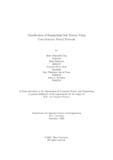Classification of Bangladeshi soil texture using convolutional neural network
Date
2022-09-29Publisher
Brac UniversityAuthor
Raj, Hafiz MohiuddinShahreen, Sazia
Shah, Muntaha Binte
Evan, Syed Washinur Ashraf
Abdullah, Juhayer
Metadata
Show full item recordAbstract
In agriculture, soil is one of the most potential output sources. That is why, if
we can foresee the soil’s nature and how it will turn in the future as well as it’s
other qualities, we may achieve adequate monitoring and sustainable agriculture field
usage. We can forecast many soil textures using different CNN models by doing Soil
classification. As a result, our major goal is to forecast it and utilize a Convolutional
Neural Network (CNN) to do so. We have applied the VGG16, ResNet50, Inception
V3, Xception, and VGG19 and these are a kind of algorithm that has the capability
to organize a huge number of images of separate divisions. Additionally, in our
research, another algorithm is used, which is deeply related to visionary purposes.
The algorithms have played a significant role in image augmentation in our research.
The input is turned into a set of filters in the hidden layers to construct feature maps
in the CNN model. We have used more than 2000 soil images as our data set, which
helped for the betterment of our research. Images of several soil samples are used
to train and evaluate these models. We have also used more than 4096 soil images
of Bangladesh, creating a new scope for our research. A machine vision system
consisting of a smartphone camera with an external lens, elimination chamber, USB
connection, and a laptop for algorithm processing activities will be used to prepare
the data. In general, the current research was carried out with five goals in mind
which will be discussed in further depth in the following sections. On photos of
different soil samples, these models were trained and tested. With the best accuracy
percentage, the suggested models could predict soil pictures. More than 90% of
accuracy from each model has been obtained, except for Xception model, where we
get an accuracy of 85%. In the end, this approach will be less costly and a waste of
time alternative to experimental methods for classifying the kind of soil textures on
a broad scale.

